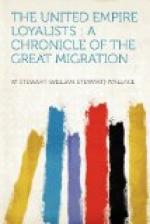Lawrence, and the various detachments were disembarked
at their respective destinations. It had been
decided that the settlers should be placed on the
land as far as possible according to the corps in
which they had served during the war, and that care
should be taken to have the Protestant and Roman Catholic
members of a corps settled separately. It was
this arrangement which brought about the grouping
of Protestant and Roman Catholic Scottish Highlanders
in Glengarry. The first battalion of the King’s
Royal Regiment of New York was settled on the first
five townships west of the provincial boundary.
This was Sir John Johnson’s regiment, and most
of its members were his Scottish dependants from the
Mohawk valley. The next three townships were
settled by part of Jessup’s Corps, an offshoot
of Sir John Johnson’s regiment. Of the
Cataraqui townships the first was settled by a band
of New York Loyalists, many of them of Dutch or German
extraction, commanded by Captain Michael Grass.
On the second were part of Jessup’s Corps; on
the third and fourth were a detachment of the second
battalion of the King’s Royal Regiment of New
York, which had been stationed at Oswego across the
lake at the close of the war, a detachment of Rogers’s
Rangers, and a party of New York Loyalists under Major
Van Alstine. The parties commanded by Grass and
Van Alstine had come by ship from New York to Quebec
after the evacuation of New York in 1783. On
the fifth township were various detachments of disbanded
regular troops, and even a handful of disbanded German
mercenaries.
As soon as the settlers had been placed on the townships
to which they had been assigned, they received their
allotments of land. The surveyor was the land
agent, and the allotments were apportioned by each
applicant drawing a lot out of a hat. This democratic
method of allotting lands roused the indignation of
some of the officers who had settled with their men.
They felt that they should have been given the front
lots, unmindful of the fact that their grants as officers
were from five to ten times as large as the grants
which their men received. Their protests, contained
in a letter of Captain Grass to the governor, roused
Haldimand to a display of warmth to which he was as
a rule a stranger. Captain Grass and his associates,
he wrote, were to get no special privileges, ’the
most of them who came into the province with him being,
in fact, mechanics, only removed from one situation
to practise their trade in another. Mr Grass should,
therefore, think himself very well off to draw lots
in common with the Loyalists.’ A good deal
of difficulty arose also from the fact that many allotments
were inferior to the rest from an agricultural point
of view; but difficulties of this sort were adjusted
by Johnson and Holland on the spot.




